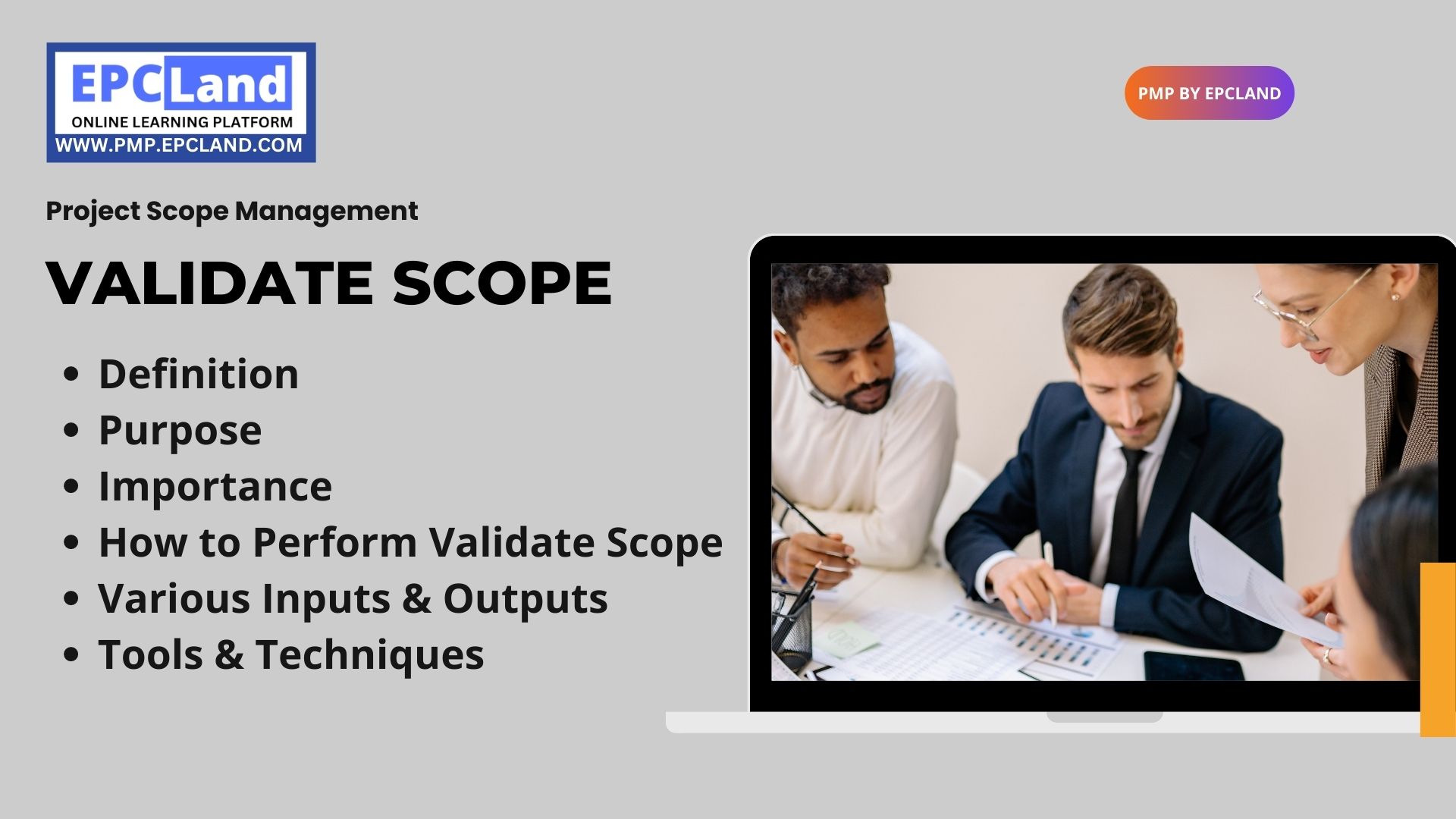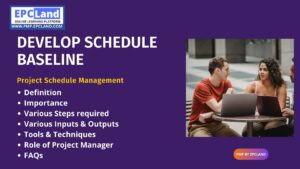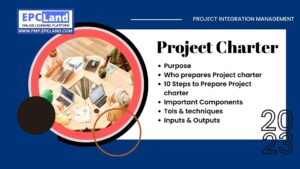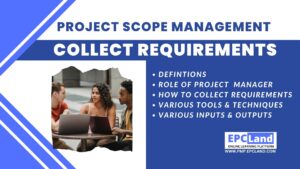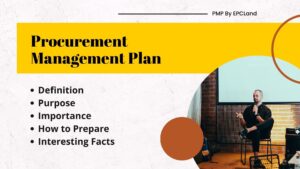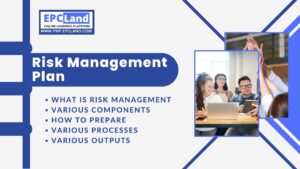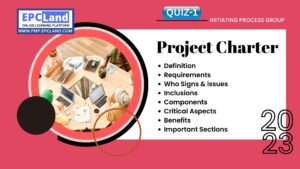Table of Contents
ToggleWhat is Validate Scope in Project Scope Management
Scope validation in project scope management is the process of ensuring that the project scope is accurate, complete, and aligned with the project objectives and requirements. It is an important step in the project scope management process that helps to ensure that the project stays on track and that any issues or changes are identified and addressed early on.
Scope validation involves reviewing and verifying the project scope, including the project objectives, deliverables, and requirements, to ensure that they are accurate and complete.
This process includes:
- Reviewing the project scope statement and other project documents to ensure that they accurately reflect the project objectives and requirements.
- Obtaining formal acceptance of the project scope from all stakeholders, including the project sponsor, customers, and other key stakeholders.
- Identifying and managing any scope changes that may occur during the project, and ensuring that they are approved and properly documented.
- Verifying that the project deliverables meet the project requirements and specifications.
- Monitoring the project progress to ensure that the project scope is being executed as planned and that any deviations from the scope are identified and addressed.
Overall, scope validation is a continuous process that is performed throughout the project lifecycle to ensure that the project stays on track, and that any issues or changes are identified and addressed early on.
Attempt Quiz-1 on Validate Scope Process

Time's up
What is Importance of Validate Scope in Project Scope Management
The importance of scope validation in project scope management is to ensure that the project scope is accurate, complete, and aligned with the project objectives and requirements. It helps to ensure that the project stays on track and that any issues or changes are identified and addressed early on.
Here are a few key reasons why scope validation is important in project scope management:
- Ensures that the project scope is accurate and complete: Scope validation ensures that the project scope is accurate and complete by reviewing and verifying the project scope statement, objectives, deliverables, and requirements. This helps to ensure that the project is properly defined and that all stakeholders have a clear understanding of what is expected.
- Facilitates effective scope management: Scope validation helps to ensure that any scope changes that occur during the project are identified and managed effectively. This helps to keep the project on track and to ensure that the project scope remains aligned with the project objectives and requirements.
- Improves project quality: Scope validation helps to ensure that the project deliverables meet the project requirements and specifications. This improves the overall quality of the project and helps to ensure that the project deliverables are fit for purpose.
- Reduces project risk: Scope validation helps to identify and manage any scope deviations that may occur during the project. This helps to reduce project risk by identifying and addressing issues early on before they become bigger problems.
- Improves project communication: Scope validation helps to ensure that all stakeholders have a clear understanding of the project scope, objectives, and requirements. This improves project communication by ensuring that everyone is working towards the same goals.
Overall, scope validation is an important step in the project scope management process that helps to ensure that the project stays on track, that any issues or changes are identified and addressed early on, and that the project deliverables are of high quality.
What are Inputs to Validate Scope in Project Scope Management
- Project scope statement: This document defines and documents the project scope, objectives, deliverables, and other requirements. It is used as a basis for scope validation.
- Project charter: This document describes the project background, objectives, and key stakeholders. It is used to ensure that the project scope is aligned with the project charter.
- Work breakdown structure (WBS): This is a hierarchical breakdown of the project into smaller, more manageable components. It is used to ensure that the project scope is accurate and complete.
- Project management plan: This document describes how the project will be managed, including the scope management plan, schedule, and budget. It is used to ensure that the project scope is aligned with the project management plan.
- Project deliverables: These are the products or services that will be delivered as part of the project. They are used to ensure that the project scope is accurate and complete.
- Stakeholder register: This document lists all the stakeholders involved in the project and their roles and responsibilities. It is used to ensure that all stakeholders are aware of the project scope and that they have formally accepted it.
What are Tools & Techniques to Validate scope
There are several tools and techniques that can be used to validate project scope in project management. These include:
- Inspection: This is a formal review of the project scope by the project team, stakeholders, and subject matter experts to ensure that it is accurate and complete. Inspection can be done through a formal review meeting, document walkthroughs, or peer reviews.
- Walkthrough: This is an informal review of the project scope, where the project team and stakeholders review the project scope together and discuss any potential issues or concerns. Walkthroughs can be done through team meetings, brainstorming sessions, or informal conversations.
- Sign-off: This is the formal acceptance of the project scope by the stakeholders, indicating that they agree that the project scope is accurate and complete. Sign-off can be done through a formal document review and approval process, or through an electronic signature system.
- Prototype: This is a preliminary version of the product or service that is developed as part of the project scope, which can be used to validate the requirements and ensure that they are feasible to implement.
- Scope Statement: This is a document, which is prepared at the beginning of the project, which defines and documents the project scope, objectives, deliverables, and other requirements. It can be used to validate the project scope and ensure that it is accurate and complete.
What are Outputs to Validate Scope in Project Scope Management
- Scope change requests: Any changes to the project scope that are identified during scope validation are documented in scope change requests.
- Scope verification: This document is used to confirm that the project deliverables meet the project requirements and specifications.
- Formal scope acceptance: This is the formal acceptance of the project scope by the stakeholders, indicating that they agree that the project scope is accurate and complete.
- Project management plan update: Any changes to the project scope that are identified during scope validation are reflected in an updated project management plan.
- Scope baseline: This is the approved project scope, including the project objectives, deliverables, and requirements. It serves as a basis for ongoing project management.
Overall, the inputs and outputs for scope validation in project scope management are used to ensure that the project scope is accurate, complete, and aligned with the project objectives and requirements, and that any issues or changes are identified and addressed early on.
How Validate Scope in Project Scope Management is performed
Scope validation in project scope management is performed through a process of reviewing and verifying the project scope, including the project objectives, deliverables, and requirements, to ensure that they are accurate and complete. This process typically involves several steps, including:
- Reviewing the project scope statement: The project scope statement is reviewed to ensure that it is accurate and complete, and that it defines and documents the project scope, objectives, deliverables, and other requirements.
- Verifying the project charter: The project charter is reviewed to ensure that the project scope is aligned with the project background, objectives, and key stakeholders.
- Reviewing the work breakdown structure (WBS): The WBS is reviewed to ensure that the project scope is accurate and complete, and that it is broken down into smaller, more manageable components.
- Verifying the project management plan: The project management plan is reviewed to ensure that the project scope is aligned with the scope management plan, schedule, and budget.
- Reviewing project deliverables: The project deliverables are reviewed to ensure that they meet the project requirements and specifications.
- Verifying the stakeholder register: The stakeholder register is reviewed to ensure that all stakeholders are aware of the project scope and that they have formally accepted it.
- Documenting scope change requests: Any changes to the project scope that are identified during scope validation are documented in scope change requests.
- Formal scope acceptance: The formal acceptance of the project scope by the stakeholders is obtained, indicating that they agree that the project scope is accurate and complete.
- Updating the project management plan: Any changes to the project scope that are identified during scope validation are reflected in an updated project management plan.
- Defining the scope baseline: The approved project scope, including the project objectives, deliverables, and requirements, is defined as the scope baseline, which serves as a basis for ongoing project management.
Attempt Quiz-2 on Validate Scope Process

Time's up
Final Take away from Validate Scope in Project Scope Management
Overall, scope validation in project scope management is a process of reviewing and verifying the project scope, including the project objectives, deliverables, and requirements, to ensure that they are accurate and complete. This helps to ensure that the project stays on track and that any issues or changes are identified and addressed early on.
FAQs on “Validate Scope" in Project Scope Management
Q: What is “Validate Scope” in project scope management?
A: Validate Scope is a process of formally accepting the completed project deliverables. It confirms that the project scope is complete and meets the customer’s expectations.
Q: Why is it important to validate the project scope?
A: It is important to validate the scope of the project because it helps to ensure that the project has met its objectives and requirements, and that the end product meets the customer’s expectations.
Q: Who is responsible for validating the project scope?
A: The project sponsor, stakeholders, and customer are typically responsible for validating the project scope. The project manager may also play a role in facilitating the validation process.
Q: What are the steps involved in validating the project scope?
A: The steps involved in validating the scope of a project include: obtaining formal acceptance from the customer or stakeholders, reviewing the project deliverables, and comparing the deliverables against the project requirements and objectives.
Q: How does project scope validation help in the success of a project?
A: Project scope validation helps to ensure that the project is completed successfully by confirming that the project scope is accurate, complete, and meets the customer’s expectations. This helps to reduce the risk of scope creep and can prevent rework and delays in the project timeline
